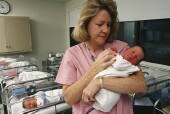
TUESDAY, Aug. 3 (HealthDay News) — Signs of autism may show up in babies as young as 1 month old, a new study shows.
But the tip-offs are not the usual red flags, such as a lack of eye contact or smiling, the researchers noted.
Instead, they found babies who needed neonatal intensive care and were later diagnosed with an autism spectrum disorder were more likely to have abnormal muscle tone and differences in their visual processing than babies who went on to develop normally after time in the neonatal intensive care unit (NICU).
The differences, which were subtle and probably not something parents would easily spot, were picked up by trained experts closely observing babies, said study co-author Ira Cohen, chair of the psychology department at the New York State Institute for Basic Research in Developmental Disabilities.
Still, “any parent concerned about the development of their child should have the child evaluated,” Cohen said.
Autism is a neurodevelopmental disorder characterized by problems with social interaction, verbal and nonverbal communication and restricted interests and behaviors.
If the study findings are borne out by future research, they might lead to earlier identification and treatment of autistic children, experts say.
For the study, published in the September issue of Pediatrics, researchers identified 28 babies who spent time in the NICU and were later diagnosed with an autism spectrum disorder. They matched them by gender and gestational age with 112 babies who did not have autism.
Babies’ behavior and development was tested at 1 month old, 4 months and periodically until they were about 2.
At 1 month, infants later diagnosed with autism were more likely to show “persistent neurobehavioral abnormalities” after hospital discharge than other babies. About 40 percent of babies later diagnosed with autism showed abnormalities in the way they visual tracked objects compared to about 10.5 percent of babies who did not get an autism diagnosis.
More than half of babies later diagnosed with autism had abnormal arm tone — either too floppy or too rigid — compared to 22 percent of babies that developed normally.
At 4 months, infants later diagnosed with autism preferred higher amounts of visual stimulation than other babies their age. To test this, researchers showed infants flashing lights at varying speed. Children were given a choice of gazing at a monitor with more or less visually stimulating lights. Researchers determined preference by measuring how long the infant gazed at each monitor.
“It fits in anecdotally with what we see later on,” Cohen said. “Kids with autism like looking at moving things in front of their eyes, such as flapping hands or following contours.”
At 7 to 10 months, babies later diagnosed with autism also showed a decline in their thinking and motor skills, perhaps as a consequence of the very early sensory and motor signs. By about 13 months, the development of children with autism started to diverge markedly from those without, according to the study.
“The rationale for trying to identify kids sooner is that you can start intervention sooner, and the data indicate the sooner you start intervention the better children do,” Cohen said.
Intervention by age 2 offers the best outcome, the authors wrote.
Researchers stressed that this research was done on babies from the NICU. More research is needed to confirm if babies born full-term and healthy who are later diagnosed with autism show similar types of abnormalities early on, Cohen said.
Recent estimates put the number of U.S. children with the disorder at one in 110, a number that has climbed steadily since the 1980s, according to background information in the study.
Previous research has found children born prematurely or of low birth weight are more likely to develop autism, though most kids with autism were not preemies, said Dr. Rebecca Landa, director of the Center for Autism & Related Disorders at Kennedy Krieger Institute in Baltimore.
Landa said medical professionals taking care of post-NICU babies should pay more attention to muscle tone abnormalities.
“One of the big take-home messages in this study is the researchers are reporting on muscle tone and visual system, things that are not what one would maybe look at or expect to be precursors to autism,” Landa said. “We are now thinking it’s not the obvious old standbys like facial expression and eye contact that will be the main signs of autism in an infant.”
More information
The National Institute of Neurological Disorders and Stroke has more on autism.

